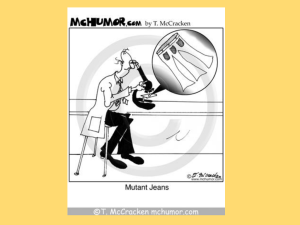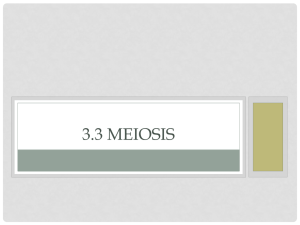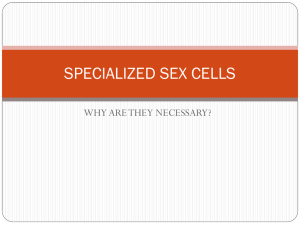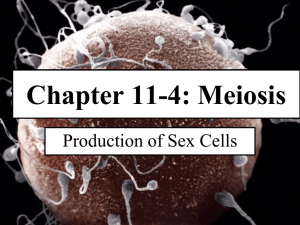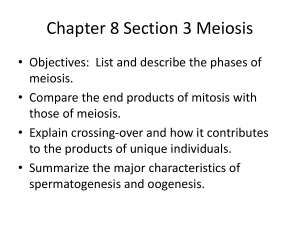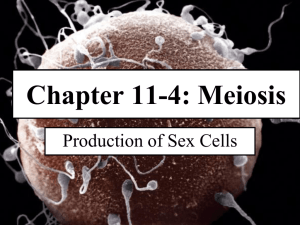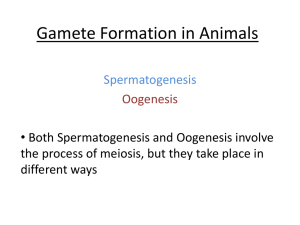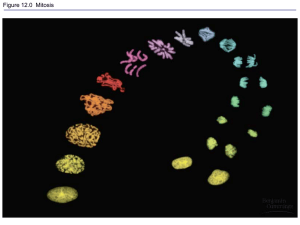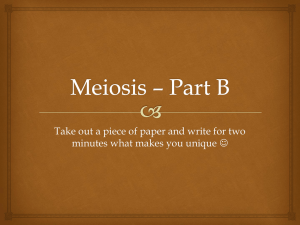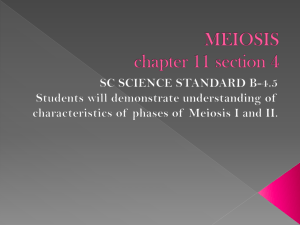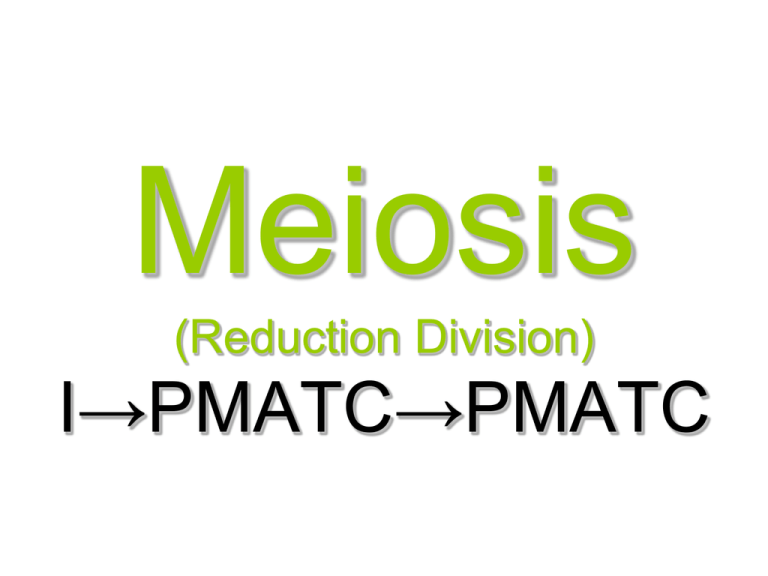
Meiosis
(Reduction Division)
I→PMATC→PMATC
Mitosis Diagram
In your journal, analyze then explain the significance of this diagram
I→PMAT→C
Pic 1
I→PMAT→C
I→PMAT→C
I→PMAT→C
I→PMAT→C
Pic 2
I→PMAT→C
I→PMAT→C
What is happening in pic 1?
What is the result in pic 2?
Meiosis vs Mitosis
Meiosis creates 4
genetically different
gametes (haploid)
Mitosis creates 2
identical daughter
cells (diploid )
Meiosis Introduction
• Process of reduction division
• Purpose: germ cells in the gonads produces
gametes (sex cells) – sperm & egg
• Meiosis is NOT A CYCLE like mitosis.
Diploid vs. Haploid
• Diploid –a full set of homologous chromosomes (one from
each parent) represented by the symbol 2N=46
– Found in somatic or body cells
• Haploid – a cell that contains only a half set of
chromosomes (one from each parent) represented by the
symbol N or 1N
– Found in gametes or sex cells – sperm & egg
• N = 23
Meiosis Introduction
Chromosome Numbers
• Somatic cells: (diploid 2N = 46 chromosomes in humans)
• Gametes: (haploid N = 23 chromosomes in humans)
You DO NOT
have to draw these
pictures on the
1st tab for
Meiosis Introduction
Just write the
Somatic and
Gamete info above
Chromosome Numbers of Some
Common Organisms
Organism
Body Cell (2n)
Gamete (n)
Human
Garden Pea
46
14
23
7
Fruit fly
Tomato
8
24
4
12
Dog
Chimpanzee
78
48
39
24
Leopard frog
26
13
Corn
Apple
20
34
10
17
1260
630
Indian fern
Meiosis Introduction
• Similar to Mitosis’ IPMATC
• Meiosis involves two distinct divisions, called Meiosis I
and Meiosis II
• By the end of Meiosis II, the 1 diploid cell that entered
meiosis has become 4 haploid cells
The next slide has a labeled picture for you to draw
Meiosis Introduction
label the steps in your diagram using your book
IPMATC→PMATC
Interphase
Prophase 1
Metaphase 1
Anaphase 1
Telophase 1 &
Cytokinesis
Prophase 2
Metaphase 2
Anaphase 2
Meiosis 1
Meiosis 2
Telophase 2 &
Cytokinesis
Interphase
• Stage between divisions
Centrioles
• Contains: centrioles and
chromatin
• Chromosome structures
have not formed yet
• Made of stages:
G1 – basic cell growth
S – replication and repair of DNA
G2 – final preparation for cell division
Nucleus
(with chromatin)
Meiosis I
Prophase I
Centrioles
• homologous
chromosomes from
each parent pair up to
form homologous pairs
• When homologous
chromosome overlap its
called crossing over.
Spindle
fibers
Homologous Pairs
(Humans have 23 pairs making
46 total chromosomes)
Prophase I
• Crossing over happens when parts of the
homologues chromosomes switch places after
overlapping
How can siblings look alike but not
exactly the same if they come from the
same parents?
Importance of crossing over
• The gene combinations
that a person gets from
his or her parents will be
different, to varying
degrees, than the
combination a sibling may
get.
• Crossing over
increases genetic
diversity
IMPORTANT CONCEPT!!
More sibling similarities
Metaphase I
homologous pairs line up
Centrioles
in the middle of the cell
Spindle
fibers
Homologous Pairs
Anaphase I
• The homologous
pairs separate
Centrioles
• Sister chromatids
don’t separate yet
Spindle
fibers
Homologous
Chromosomes
Anaphase I
• If the chromosomes
don’t separate
correctly then a
Nondisjunction will
occur
• THIS IS BAD
Centrioles
Spindle
fibers
• Example: downs
syndrome 2N+1=47
Homologous
Chromosomes
Important attributes of Meiosis I
• “Crossing” over happens in prophase I
• The homologous PAIRS separate in anaphase
I which makes the daughter cells unique
• The amount of DNA is still twice what it needs
to be for a gamete...so we are not done yet!
Meiosis I makes
• 2 haploid (1n) cells that are genetically unique
but the sister chromatids have not separated
yet.
Anaphase I
if a Nondisjunction happens in Meiosis I
• A Nondisjunction causes
the gametes to have the
wrong amount of
chromosomes
Telophase I & Cytokinesis
Centrioles
• Telophase I – the cell
creates a temporary
nucleus around the
chromosome sets
• Cytokinesis – the cell
divides into two cells
Nuclear Membrane
Homologous
Chromosomes
Meiosis II
• The two cells produced by meiosis I now enter a
second meiotic division
• The cells do NOT replicate DNA (no more
interphase)
• Each cell has
half of the
original DNA
• 2N ÷ 2 = N
Prophase II
• Similar to Prophase of
Mitosis
• Centrioles attach
spindle fibers to the
chromosomes
Centrioles
Chromosomes
Spindle
fibers
Metaphase II
• Similar to Metaphase
of Mitosis
• chromosomes line up
in the middle
Centrioles
Chromosomes
Spindle
fibers
Anaphase II
• Sister chromatids
separate
• Each chromatid is
pulled to the opposite
pole of the cell
Centrioles
Spindle
fibers
Chromatids
Telophase II & Cytokinesis
• Telophase II – the
cells create a new
nuclear membrane
around the
chromosomes
Chromatids
• Cytokinesis – the
cells divides into four
haploid daughter cells
Nuclear Membrane
Important attributes of Meiosis II
• The SISTER chromatids separate in anaphase II
• This makes each new 1n cell unique
• Meiosis II will result in gametes
Meiosis II makes
• 4 haploid (1n) cells that are genetically unique
and contain ½ the DNA of the original 2n cell
Gamete (Sex Cell) Formation
• In male animals
(including humans),
the haploid gametes
produced by meiosis
are called sperm
• 4 sperm cells are
produced from one
meiotic division
Gamete (Sex Cell) Formation
• In female animals (including
humans), the haploid
gametes produced by
meiosis are called eggs
• The cell divisions at the end
of meiosis I & II are uneven,
so that 1 large egg is
produced along with
3 other cells, called polar
bodies, which are discarded
and not involved in
reproduction
Meiosis Animation
• The following slide shows a simple
animation using a cell with 2 pairs of
homologous chromosomes going through
meiosis.
Meiosis Animation
Meiosis I Animation
http://wps.prenhall.com/wps/media/objects/4
87/498728/CDA9_1/CDA9_1b/CDA9_1b.ht
m
Meiosis II Animation
http://wps.prenhall.com/wps/media/objects/4
87/498728/CDA9_1/CDA9_1c/CDA9_1c.ht
m
Vocabulary
Reduction division – When the number of chromosomes per cell is cut in half
Haploid – A cell that has half the amount of chromosomes.
A cell that is “N” for chromosome amount
Diploid – A cell that has twice the amount of chromosome.
A cell that is “2N” for chromosome amount
Germ Cell – cells found in the gonads that produce gametes (sperms & eggs)
Gamete – the haploid “sex” cells (in animals they are sperm and egg cells)
Somatic Cell – all diploid cells (body cells) that are not gametes
Zygote – fertilized egg cell formed form the joining of the gametes (sperm and
egg)
Vocabulary
Centrioles – Organelles in the cell that help to move chromosomes during cell
division
Chromatin – What you call the DNA during Interphase, Very easy to access
the genes for transcription and translation to create proteins
Chromosome – What you call the DNA during the actual cell division stages
(Pro-, Meta-, Ana-, and Telophase).
Condensed/packed DNA for easy movement during cell division
Chromatid – One of the “arms” of a chromosome ‘X’. Each chromatid is
identical to the other because it is created by replication.
A chromosome is made of two Sister Chromatids.
Spindle Fiber – fibers created and used by the centrioles to move the
chromosomes around during the division stages.
Vocabulary
Homologous Chromosomes – the same numbered chromosome that pair up
from mother and father (ex: mom’s chromosome 1 and dad’s chromosome 1)
Crossing Over – A kind of chromosomal mutation that happens in Prophase 1
of meiosis.
Homologous chromosomes overlap and exchange pieces of the
chromosome which caused genetic variability.
Nondisjuction – Happens in either Anaphase 1 or Anaphase 2 of meiosis
when one centriole does not connect to the chromosome with a spindle fiber.
Causes the gametes to have extra or missing chromosomes.
Fertilization – The process of making a zygote. When egg and sperm cells
fuse and combine their genetic information (DNA)
Comparing Mitosis to Meiosis
Mitosis
Starting cells
Ending cells
Number of Human Chromosomes
Genetic Make up of cells
Type of cells
Purpose
Meiosis
Comparing Mitosis to Meiosis
Mitosis
Meiosis
1 Diploid cell
1 Diploid cell
2 Diploid cells
4 Haploid cells
2n=46
N=23
Both cells are identical
All 4 cells are genetically
unique
Type of cells
Somatic cells for growth
replacement repair
Gamete cells for sexual
reproduction
Purpose
growth replacement repair To create gametes for
fertilization
Starting cells
Ending cells
Number of Human Chromosomes
Genetic Make up of cells
• Use the following slides to complete the
table.
Comparing Mitosis & Meiosis
Number of cells at beginning of process
– Mitosis = 1 Diploid cell
– Meiosis = 1 Diploid Cell
Number of cells at the end of the process
– Mitosis = 2 Diploid Cells
– Meiosis = 4 Haploid Cells
Comparing Mitosis & Meiosis
Number of chromosomes at the START
Mitosis- 46 (Diploid, “23 pairs, or set of two”)
Meiosis- 46 (Diploid, “23 pairs, or set of two”)
Number of chromosomes at the END
Mitosis- 46 (Diploid, “23 pairs, or set of two”)
Meiosis = 23 (Haploid, “23 singles, or set of
1/2”)
Comparing Mitosis & Meiosis
Is the genetic make-up of the daughter
cells UNIQUE or IDENTICAL?
– Mitosis produces 2 IDENTICAL CELLS
– Meiosis produces 4 UNIQUE CELLS
Comparing Mitosis & Meiosis
• Type of cell in the human body that can
undergo each phase
Mitosis produces Somatic BODY cells (skin)
Meiosis produces Gamete SEX cells (sperm
or eggs)
Comparing Mitosis & Meiosis
• Purpose:
– Mitosis creates cells for
•
•
•
•
Growth
Replacement
Repair
Asexual reproduction
– Meiosis creates cells for
• Sexual reproduction in humans and many other
species
Interesting Facts
• Females produce all their eggs at once,
and store them at a very early age (They
release one each month during
mentration)
• Males make sperm constantly from
puberty until they die.

